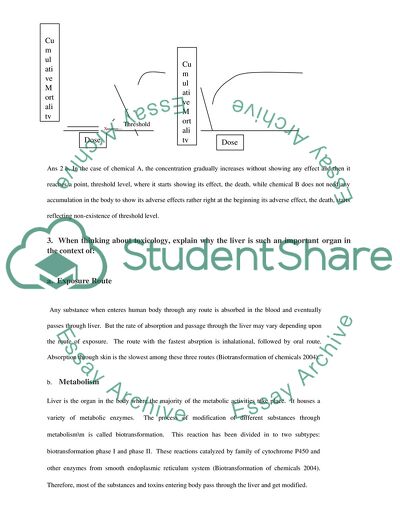
- Home
- Free Samples
- Premium Essays
- Editing Services
- Extra Tools
- Essay Writing Help
- About Us
- Studentshare
- Subjects
- Miscellaneous
- Introduction to Environmental Health Sciences (Toxicology & Exposure Assessment)
Introduction to Environmental Health Sciences (Toxicology & Exposure Assessment) - Essay Example
Ans 2a. Usually, the non-carcinogens accumulate in the body for a…

- Subject: Miscellaneous
- Type: Essay
- Level: Undergraduate
- Pages: 4 (1000 words)
- Downloads: 0
- Author: watersdianna
Extract of sample "Introduction to Environmental Health Sciences (Toxicology & Exposure Assessment)"
a downward slope showing effect on IQ at the very beginning at very low concentration and then the effect decreases with increase in the concentration. This is why there is no threshold level in this study. b. On the following two graphs where the y-axis represents cumulative mortality (%) and the x-axis represents increasing dose, please label the threshold on the graph where appropriate, and describe in your own words the contrast between the population response to chemical A versus chemical B. Ans 2 b. In the case of chemical A, the concentration gradually increases without showing any effect and then it reaches a point, threshold level, where it starts showing its effect, the death, while chemical B does not need any accumulation in the body to show its adverse effects rather right at the beginning its adverse effect, the death, starts reflecting non-existence of threshold level.
Any substance when enteres human body through any route is absorbed in the blood and eventually passes through liver. But the rate of absorption and passage through the liver may vary depending upon the route of exposure. The route with the fastest absrption is inhalational, followed by oral route. Absorption through skin is the slowest among these three routes (Biotransformation of chemicals 2004). Liver is the organ in the body where the majority of the metabolic activities take place. It houses a variety of metabolic enzymes.
The process of modification of different substances through metabolism\m is called biotransformation. This reaction has been divided in to two subtypes: biotransformation phase I and phase II. These reactions catalyzed by family of cytochrome P450 and other enzymes from smooth endoplasmic reticulum system (Biotransformation of chemicals 2004). Therefore, most of the substances and toxins entering body pass through the liver and get modified. Metabolic phase II reactions are conjugation reactions, which make substances more water soluble and
...Download file to see next pages Read MoreCHECK THESE SAMPLES OF Introduction to Environmental Health Sciences (Toxicology & Exposure Assessment)
Chemical Substance Bisphenol A
Formal report and work plan
Toxic Effects on the Structure of DNA
Heavy Metal in the Context of Environmental Toxicology
Career of Environmental Health Specialist
Environmental Disease: Bisphenol A
Environmental Health and Public Health Risk Assessment
Epidemiology and Toxicology

- TERMS & CONDITIONS
- PRIVACY POLICY
- COOKIES POLICY